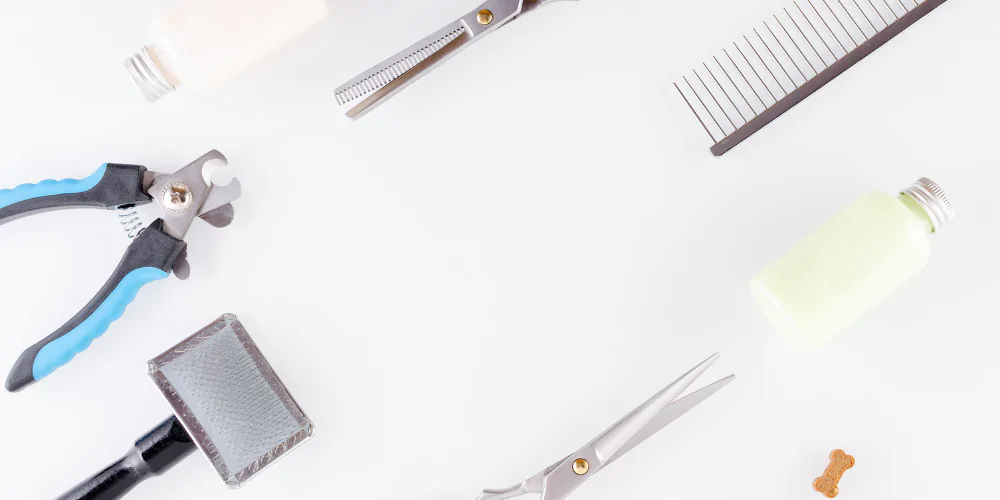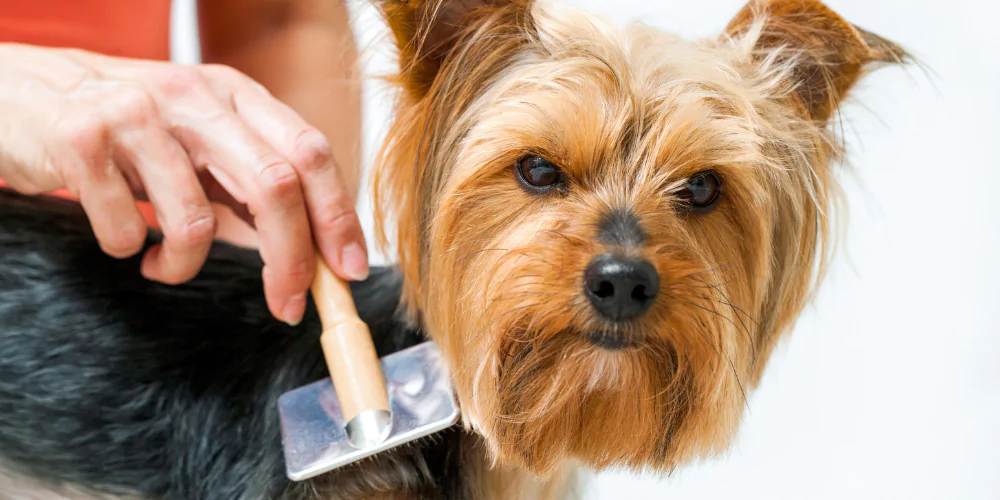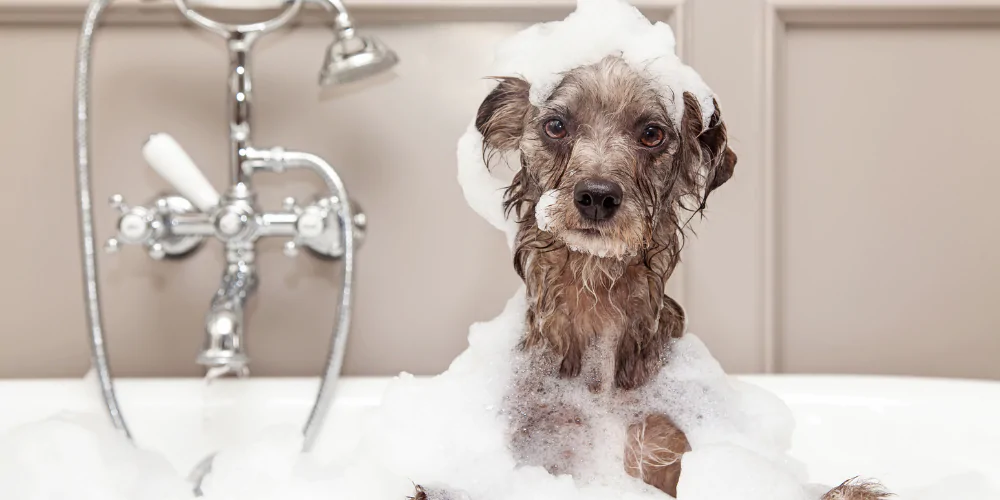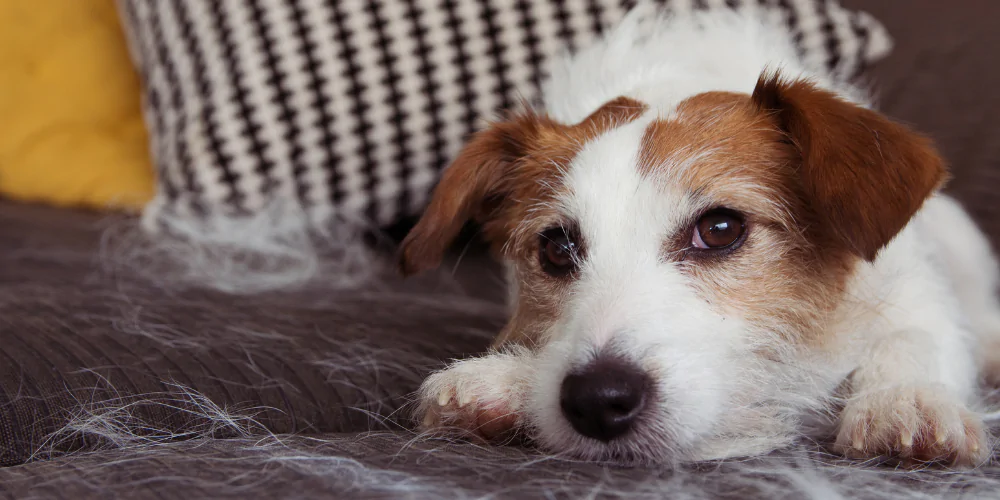
How to groom a dog

Allie Simpson
8 October 2021 | 8 minutes read
As a pawsome dog owner, you want to keep your canine best friend as happy and healthy as possible. Regular grooming will help your pooch look and feel their best. Whether it’s a trip to a professional groomer, or an at-home grooming routine, here’s some things you need to know about dog grooming.

What equipment do I need for dog grooming?
You might have some basic items around the house that are suitable for your dog, but here are some other dog grooming equipment you may need.
> Doggy shampoo and conditioner
Experts say you should always opt for doggy shampoo and conditioner, as human shampoo can dry out their skin. It could also leave them at risk of skin problems such as parasites, bacteria, and viruses.
> Brush
When it comes to brushes, there’s a range of options available depending on your pooch’s fur and grooming needs.
- Slicker brushes are designed for untangling your dog’s fur, but aren’t for use on shorter hair breeds.
- A bristle brush is ideal for keeping your dog’s coat looking shiny and healthy, as well as removing loose hair.
- Another option is a double-sided brush. The pin brush side is great for removing tangles and matted fur from your dog’s coat. The bristle side will help smooth your dog’s coat and keep it looking glossy.
- If your dog has fleas, consider a flea comb for helping to get rid of them, along with flea dirt and eggs.
> Dog clippers
Not all dogs will need their coat trimming, but if your dog’s coat is in need of a spruce, make sure you have dog clippers. Opt for pet clippers as human clippers can injure your pooch. Pet clippers are also typically manufactured to be much quieter, to keep your dog at ease.
Clippers can be more precise than scissors, while scissors can be useful for sensitive areas. Scissors may also help your pet if they are anxious around the noise of a clipper.
> Nail clippers
Dogs are born roamers and keep their nails cut back naturally by walking on harder surfaces. Even so, there are some dogs (such as our older canines), who may still need their nails manually clipped.
Keep an eye on the length of your dog’s nails, especially if they start touching the ground. Pet nail clippers and nail grinders can be used to keep your dog’s nails trimmed.
How to restrain a dog while grooming
There are several restraints available to buy from your local pet shop and you’ll want to try it on your dog to make sure it fits comfortably. A restraint will typically have a loop that goes around your dog’s belly and an attachment to their collar.
Alternatively, you may want to paw-litely ask for an extra pair of hands to hold your dog still whilst you brush, clip, and trim their fur. The bathtub (or a sink for smaller breeds) can be helpful as a place for bathing your dog as it keeps them contained and still.

Dog grooming training
It’s important to start getting your dog used to a grooming routine as early as you can. You’ll want to gradually introduce your pup to each grooming tool one at a time.
> Introducing your dog to a brush
Introducing your dog to a brush is all about going at a slow pace and using plenty of positive reinforcement. As we mentioned, starting at puppy age can also help make the process easier.
- First, let your dog first sniff the brush. Praise and give them a treat for their interest or indifference – the idea is to avoid reinforcing any negative reactions.
- Next, gently stroke the brush across your dog’s fur with the outer bristles. To begin with, keep the time that you brush your dog to short sessions while they get used to the sensation.
- Once your dog is more comfortable, you can use firmer pressure and build up to longer brushing sessions.
Don’t forget to keep those tasty, high reward treats close by to praise your pup as you work through each step.
> Introducing your dog to nail clippers
You may want to prepare your dog for their first time having their nails clipped by getting them used to having their paws handled.
- Use treats for positive reinforcement every time your dog lets their paws be touched.
- Teaching your dog to give a high five or to shake your hand with their paw is another way to help your dog feel comfortable with having their paws touched.
- Once your dog is comfortable with having their paws handled, introduce the nail clipper.
- For their first time, don’t clip their nails, simply touch their paws with the utensil. Again, use treats and verbal praise for positive reinforcement.
- If in doubt, take your pup to a professional groomer.
Your dog may still be nervous the first time you trim their nails, but by slowly repeating these steps, and with lots of paws-itive encouragement, you could get them used to this part of the grooming routine.
> How can I calm my dog down for grooming?
As the saying goes, slow and steady wins the race. Getting your dog used to grooming will require a lot of patience. Even then, your dog may still get nervous or anxious, so try and maintain a positive environment.
Some dogs may be more comfortable being groomed at home by their owner, as the unfamiliar noises and smells of a professional salon can be overwhelming. Others are more than happy to be groomed by a professional. Do what’s best for your dog and don’t force them into a grooming set up they don’t like.
Positive reinforcement is key if your dog tends to get worked up when it comes to groom-time. Arm yourself with treats, and give them lots of verbal praise and encouragement to help them feel at ease.

How to groom your dog at home
If you’re thinking of trying at-home grooming, find a quiet place without any distractions to help your dog remain calm. Once you’ve built up their confidence with grooming tools, here’s an example of a routine you can do:
- Gently pop your pooch into a bathtub or sink. Use a damp cloth to wipe the flaps of your dog’s ears, and to clean away any dirt that may be gathered around their eyes.
- Use doggy shampoo and conditioner to keep your dog’s fur in good condition and their coat smelling lovely and fresh.
- Follow up by towel drying them as best as you can. A hair dryer may be effective for drying your dog’s coat, but only if they are comfortable with the noise and feel.
- Once their coat has dried, it’s time for a trim! Experts recommend starting from their neck and finishing at their tail. Trim with the direction their fur flows, and start with a larger clipper size to prevent too much fur from being taken off.
- Take extra care in sensitive areas, such as their belly, genitals, and face. You may prefer to use scissors in these areas.
- For clipping your dog’s nails, make sure you know where their nail quick is (after the curve of the nail). Don’t cut at the quick as this can cause your dog’s nail to bleed.
- Lastly, after their grooming session, make sure you give them lots of cuddles and reward them with a treat. This will help them to feel com-fur-table with grooming in the future.

How often should a dog be groomed?
How often your dog needs grooming varies depending on their breed, coat type, and coat length.
Longer hair breed dogs, such as Collies, Shelties, Yorkshire Terriers, and Tibetan Terriers, may need brushing every day to make sure their coat stays in fine condition. If you don’t regularly brush their coats, their fur could become matted.
Breeds with an undercoat need what’s known as stripping. These are typically breeds with a wiry coat, such as Schnauzers, Cocker Spaniels, and Airedale Terriers. Experts recommend having their coats stripped around four to six times a year.
Medium hair breeds, such as German Shepherds and Pomeranians, may need to be brushed several times a week and a trim a couple of times a year.
Short hair breeds, like Staffies and Labradors, may only need to be brushed once a week and don’t need trims.
All breeds of dogs shouldn’t be bathed too regularly, as this can dry out their skin and cause skin irritation. Experts recommend that dogs should only be bathed around once every three months or if they have rolled in something smelly (we’re looking at you, fox poo). Make sure you use dedicated dog shampoo and conditioner when bathing them too.
Your dog deserves the best, from keeping their coat in tip-top condition to lifetime dog insurance with a difference. We’re standing up to pet inequality with tailored dog insurance worth wagging your tail for.


